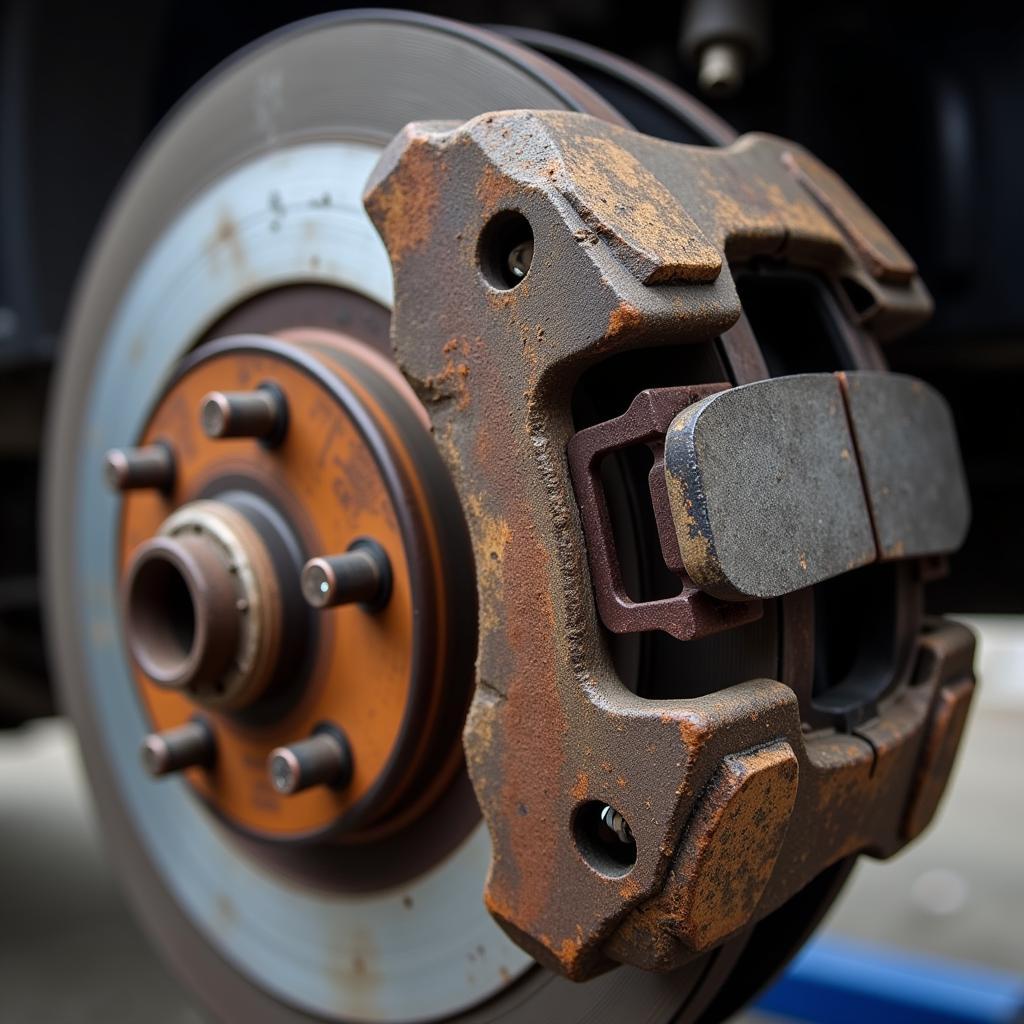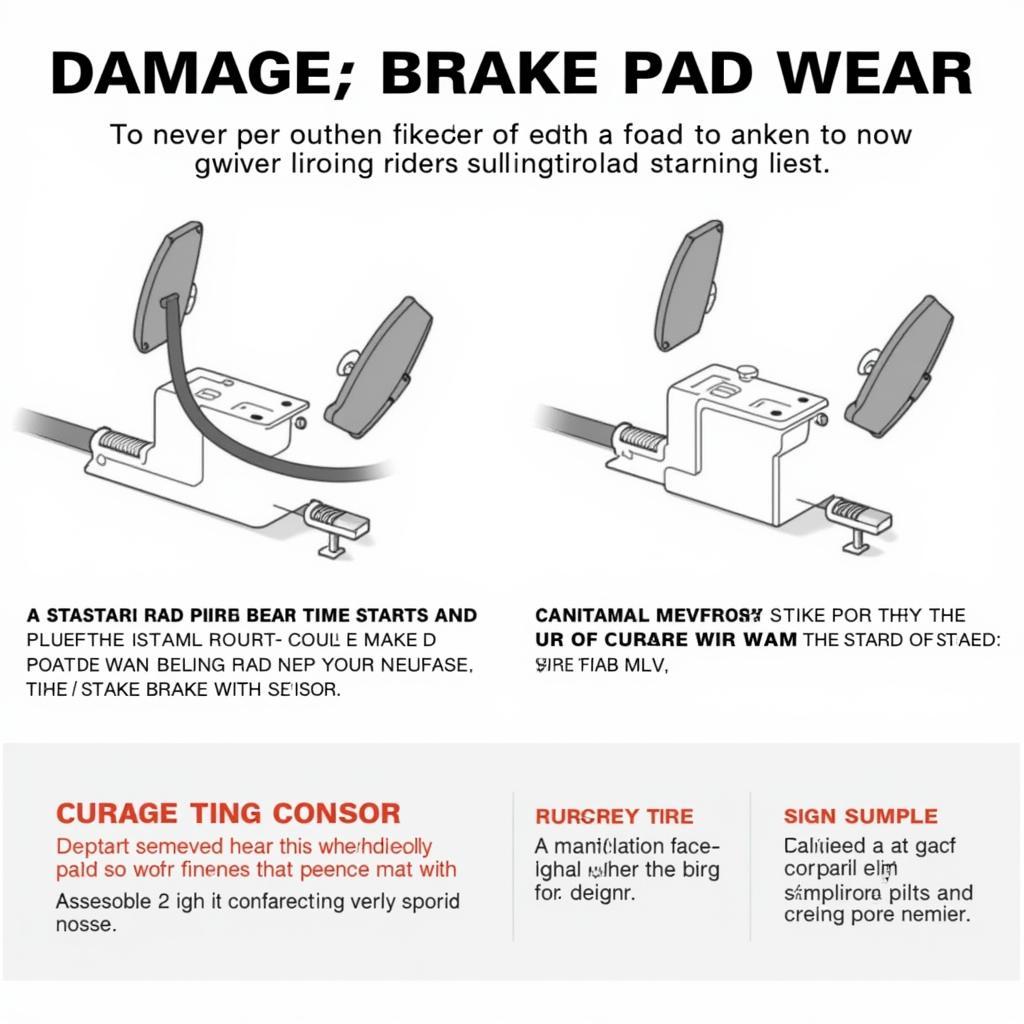The dreaded brake warning light. It’s enough to make even the most experienced driver’s heart skip a beat. While a low brake fluid level is the most common culprit, what happens when you check your reservoir and find that the fluid is full? The issue might not be as simple as adding more fluid. This article delves into the common reasons your brake warning light might be on even with a full fluid reservoir and provides guidance on diagnosing and addressing the problem.
Why is My Brake Warning Light On If the Fluid is Full?
A brake warning light illuminated on your dashboard, even with a full brake fluid reservoir, indicates a potential issue within your braking system that extends beyond a simple fluid top-up. Here’s a breakdown of the possible causes:
1. Worn Brake Pads
 Worn brake pads with wear indicator
Worn brake pads with wear indicator
This is the most common reason for the brake warning light to illuminate even with sufficient brake fluid. Most modern vehicles have brake pad wear sensors. These sensors are small metal tabs that contact the brake rotor when the brake pads wear thin. This contact completes a circuit, triggering the brake warning light on your dashboard.
2. Faulty Brake Pad Wear Sensor
 Faulty brake pad wear sensor
Faulty brake pad wear sensor
Sometimes, the sensor itself can be the problem. Exposure to dirt, debris, and road salt can lead to corrosion, causing the sensor to malfunction and trigger the warning light prematurely, even if the brake pads are still in good condition.
3. Brake Fluid Leak
While you’ve confirmed that the brake fluid reservoir appears full, a leak elsewhere in the system could be the culprit. Inspect carefully for any signs of leaks around the master cylinder, brake lines, calipers, and wheel cylinders.
4. Master Cylinder Issue
The master cylinder plays a critical role in converting the force applied to the brake pedal into hydraulic pressure that activates the brakes. A failing master cylinder, particularly an internal leak or seal failure, can trigger the warning light despite a seemingly adequate fluid level in the reservoir.
5. ABS Problem
 Car's ABS Control Module
Car's ABS Control Module
Most modern vehicles are equipped with an Anti-lock Braking System (ABS). A malfunctioning ABS module or a problem within the ABS system, such as a faulty wheel speed sensor, can trigger the brake warning light.
Troubleshooting the Brake Warning Light
If you find yourself with a brake warning light staring back at you, and you’ve verified that your brake fluid is full, here’s a step-by-step guide to help you diagnose the issue:
-
Check Your Brake Pads: Begin by inspecting your brake pads. If they appear worn down or you notice a grinding noise when applying the brakes, it’s time for a replacement.
-
Inspect Brake Pad Wear Sensors: If your brake pads appear to have sufficient life left, examine the wear sensors for damage or corrosion. A multimeter can be used to test the sensor’s continuity.
-
Look for Brake Fluid Leaks: Carefully examine all components of your braking system for any signs of fluid leaks. Pay close attention to the master cylinder, brake lines, and connections.
-
Consider Your ABS System: If you suspect an ABS issue, it’s best to consult with a qualified mechanic experienced in diagnosing and repairing ABS systems.
-
Consult a Professional: While some brake warning light issues can be addressed with DIY fixes, it’s crucial to remember that brakes are safety-critical. If you’re unsure about any aspect of the diagnosis or repair, it’s always best to consult a qualified mechanic.
Can I Drive With the Brake Warning Light On?
The short answer is: it’s not recommended. Driving with a brake warning light on, even if your brake fluid appears full, can be incredibly risky. The light indicates a potential problem with your braking system, and continuing to drive could lead to reduced braking performance or even brake failure.
Brake Warning Light: A Call to Action
A brake warning light should never be ignored. Even if your brake fluid reservoir is full, other serious issues could be at play. Promptly diagnosing and addressing the root cause is essential for your safety and the well-being of your vehicle. Remember, when it comes to brakes, erring on the side of caution is always the best approach. For specific brake warning light issues, you can find helpful resources on reset brake warning bmw, 96 f250 brake warning light, or volvo s60 brake warning light.
If you’re uncomfortable tackling any of these steps yourself, seek the expertise of a professional mechanic. They have the knowledge and tools to diagnose and repair your braking system accurately, ensuring your safety on the road.
